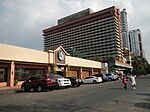Malate Church

The Our Lady of Remedies Parish, also known as Malate Church (Spanish: Iglesia Parroquial de Malate), is a parish church in the district of Malate in the city of Manila, Philippines. This Mexican Baroque-style church is overlooking Plaza Rajah Sulayman and, ultimately, Manila Bay. The church is dedicated to Nuestra Señora de los Remedios, the patroness of childbirth. A revered statue of the Virgin Mary in her role as Our Lady of Remedies was brought from Spain in 1624 and stands at the altar. Malate used to be known as Maalat due to the saline waters of the bay; and as Laguio or Lagunoi, the name of the street which separated it from Ermita. It is located by Manila Bay, very close to the sea. One main street crosses it at the center. It is wide and beautiful and leads up to Cavite. The numerous trees make this road a pleasant walk. It lies just three kilometers from the center of Manila.
Excerpt from the Wikipedia article Malate Church (License: CC BY-SA 3.0, Authors, Images).Malate Church
Marcelo H. del Pilar Street, Manila Malate (Fifth District)
Geographical coordinates (GPS) Address External links Nearby Places Show on map
Geographical coordinates (GPS)
| Latitude | Longitude |
|---|---|
| N 14.569326 ° | E 120.984742 ° |
Address
Our Lady of Remedies (Malate Church)
Marcelo H. del Pilar Street
1004 Manila, Malate (Fifth District)
Philippines
Open on Google Maps









